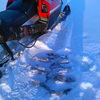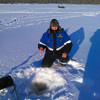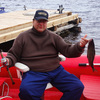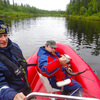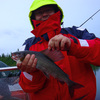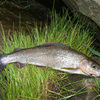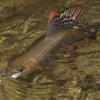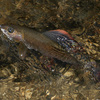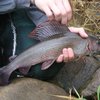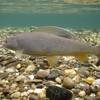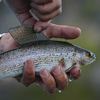Grayling
Grayling (lat. Thymallus) – Fish species of the sub-species Thymallus of the salmon family of the salmoniformes order. There differentiating characteristic is the large dorsal fin, covered with a pattern of spots or streaks and the rear part of it, in the adult male fish, when folded, reaches the adipose and sometimes even the tail fins. The small adipose fin on the grayling’s back highlights the fish’s ancestry and its genealogical connection with the salmoniformes.
According to L. P. Sabaneev, the Grayling has one of the most beautiful shadings among the fish, found in the waterways of the Northern Hemisphere. This fish has single shaded dark-grey back, whereas the sides of some types have black spots of various forms. This fish stand-out from other fish in the species due to tis small mouth, i.e. the upper jaw does not extend beyond the front edge of the eye. Its teeth are very weak, nearly unnoticeable and the gill rakers are 20-29. The nuptial changes include the increase in saturation of colours. In the males, the height of the rear part of the dorsal fin also increases.
The grayling grows maximum to a length of 50 cm and can grow as large as 2.5 to 3.0 kg in weight. There are known cases of fishing a larger specimen. The largest ever fish was 6.7 kg in weight and was fished out of Konnevesi Lake in Finland in 1956. The average weight of catch is no more than 1 kg per piece.
The grayling is a close relative of the salmoniformes and the whitefish. It is found in clean cold water (fresh water) rivers and lakes, preferably living in reservoirs with pebbly or stony beds. It can evolve into only river, lake-river and only lake forms. The usual grayling prefers water ways where water holes interleave with rifts. In many cases it even gets into Lake Ladoga, Lake Onega and Imandra, from where it goes into the rivers for spawning. The grayling in our North regularly comes close to the wellheads and at places its concentration is great enough to allow for commercial fishing.
The grayling is practically an omnivorous creature. Normally it eats low growing organisms – small crustaceans, Gammarus, shell fish, larvae and other forms of submarine insects (dayfly, caddis fly, stone flies), as well as various supra marine insects, which accidentally fall into water – crickets, frog lies, gad-fly, black-fly (this is why leisure grayling fishing is done using the black fly). The grayling also likes to eat the fish roe.
Large size grayling also eats young fish and in rare cases they can also attack small mammals (field mice, shrew mice etc.) which dare swim through the river.
I spring, April – May, the graylings, who lay low in the under currents in winter, leave their “homes” and float up, often even under the ice, right to the top and by the start of the melting season (flooding) they go to the tributaries for spawning.
You can note the similar kind of behaviour among the lake-river type populations of graylings. The only difference is that from the lakes the fish can not only go to the tributaries and streams, but can also go downstream to the confluent rivers. Together with the adult population (grayling reaches adulthood on the 3-5th year of their lives), the younger fish also undertake the spring migratory path. For the younger fish such migrations are only exploratory. The young graylings have broad cross-bands resembling the salmon parr.
The grayling spawns in May – early June when the water temperature is around +5-10OC, on the pebbly-sandy parts with considerably strong currents and depth of 30-60 cm. The lake populating graylings spawn in shallow water near the shores of the lake.
The growing period among the river dwelling populations extends into October. As the cold sets-in, before the formation of the first ice, the graylings again, just as in spring, start off on their journey. But now they are headed to the habitual spots for passing winter. Similar is the routine for many river-lake types of grayling. Among the former there are such exotic types, who after spawning prefer to return for growing to the lake.
During the growing period the grayling in the river spreads out along the current as per age. Near the lower end of the current you will find smaller fish, whereas near the upper parts, larger fish. This is easily understandable. To go upriver the fish has to spend a considerable amount of energy, continuously fighting against the current and other natural obstacles. The younger grayling lacks such force.
The grayling always commends fishermen’s attention. The thing is that it is not so easy to fish, which attracts the fishermen like a magnet of challenges. Except for that the grayling has tender, fat and very tasty meat, which in some way resembles that of trout. So it is not only fished for interest. Currently this fish is under strict quota and can only be caught under a license. But there still is some commercial catch, which might not be so large in volume.
The best equipment for grayling fishing is the fly and float tackle with feed (usually fishermen use metallic lure with a sandwich of maggots and worms.). It is also possible to angle grayling with spinning and troll.
